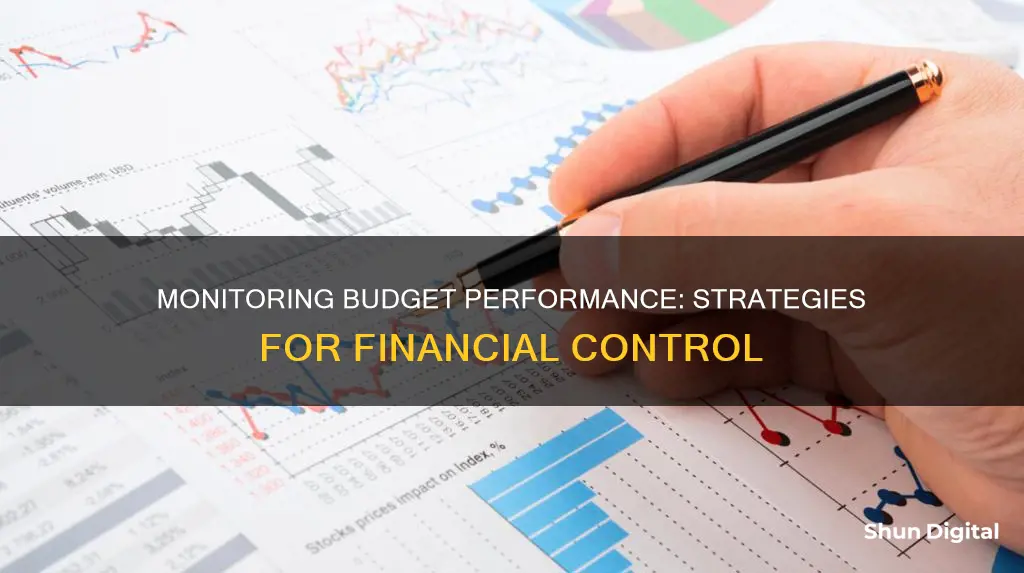
Budgeting is an essential skill for any business owner or manager who wants to plan ahead, allocate resources, and measure performance. However, creating a budget is not enough; regular monitoring and adjustments are necessary to reflect changing conditions and goals. This process involves comparing the actual results with the expected outcomes, identifying deviations, and taking corrective actions. Budget monitoring is crucial for enforcing accountability in spending, evaluating service level provisions, and ensuring progress towards goals. This paragraph will discuss strategies and best practices for monitoring budget performance, including setting clear goals, using budget dashboards, and involving the team in the budget monitoring process.
| Characteristics | Values |
|---|---|
| Timeframe | Depends on the nature and size of the business. Could be weekly, monthly, quarterly, or annually. |
| Comparison | Compare actual performance with budget goals, analyse revenue and expenses, and identify trends. |
| Variance Analysis | Identify areas where performance differs from expectations and take corrective action. |
| Key Performance Indicators (KPIs) | Sales growth, gross margin, operating income, return on investment, customer satisfaction, and employee retention. |
| Flexibility | Adjust the budget as needed to reflect changing conditions and goals. |
| Communication | Share budget goals and performance with staff, partners, and stakeholders to foster accountability and transparency. |
| Technology | Leverage software and automation to monitor budget performance in real-time and improve efficiency. |
| Goals | Set clear and realistic short-term and long-term goals that are specific, measurable, achievable, relevant, and time-bound (SMART). |
What You'll Learn

Budget variance analysis
To conduct a budget variance analysis, a budget dashboard can be a useful tool, allowing for real-time data visualisation and analysis. It helps identify trends and patterns and highlights areas of concern or opportunity. It also fosters accountability and transparency by enabling communication of budget performance to staff, partners, and stakeholders.
In addition to the budget dashboard, other tools such as accounting software can be beneficial for budget variance analysis, especially as the business grows and the volume of expenses and sales revenue increases. This software can automatically generate budget reports, fill in fields for actual amounts, and provide estimates. However, it is important to not overly rely on computerised forecasting, as human knowledge of the market may provide a more accurate estimate.
Monitors: Comparing Color Accuracy Directly
You may want to see also

Key performance indicators
Sales growth, gross margin, operating income, return on investment, customer satisfaction, and employee retention are some common KPIs for budgeting and forecasting. Tracking and reporting on these KPIs allows for performance monitoring, results communication, and team motivation.
To improve business performance, it is essential to identify and monitor a few key drivers, or factors with a significant business impact. The three main drivers for most businesses are revenue, cash flow, and profitability. Monitoring these drivers against budgets and forecasts can help identify problems early on and spot trends that may impact future operations.
When monitoring budget performance, it is also important to compare budgeted and actual revenues, examining sources of funds and potential volatility. Additionally, tracking expenditures, including payroll, hiring, vacancy, and part-time or overtime pay, is crucial. Non-personnel expenditures, such as encumbrances, outstanding purchase orders, and major contracts, should also be analysed to understand what has been spent and what remains to be spent.
Ankle Monitors: How Long Do They Stay On?
You may want to see also

Budget review and revision
Frequency of Review and Revision
The frequency of budget review and revision can vary depending on the nature and size of your business. It can be done monthly, quarterly, or annually. For startups or small businesses, a short-term budget covering three months or less is more manageable, and with time, it can be extended to six-month or annual budgets as trends become easier to identify. Regularly revisiting your budget helps keep it aligned with the dynamic nature of your business and the market.
Comparison with Actual Results and KPIs
When reviewing your budget, compare it with your actual financial results and Key Performance Indicators (KPIs). Analyze the variances and causes for any discrepancies. KPIs are measurable values that show how well your business is achieving its objectives. They can be financial or non-financial but should be relevant, specific, and aligned with your budget goals. Examples include sales growth, gross margin, operating income, return on investment, customer satisfaction, and employee retention.
Analyzing Variances and Identifying Causes
During the budget review process, it is important to go beyond simply identifying deviations from the budget. Analyze and understand why these deviations occurred to work towards a resolution. This involves examining a broad set of functions and indicators, including revenues, expenditures, personnel, non-personnel, operations, capital, and economic trends. For example, analyze payroll expenses, hiring and vacancy information, part-time and overtime pay, and fringe benefit costs under the personnel category.
Evaluating Performance and Progress
Evaluate your performance and progress against your budget. Assess whether your business is meeting its financial, operational, and capital goals. This evaluation will help identify areas where your business is performing better or worse than expected, allowing you to make data-driven decisions and corrective actions.
Adjusting and Communicating Budget Revisions
When revising your budget, adjust it to incorporate new information, assumptions, and goals. Communicate these changes to your stakeholders, including your team members, to ensure a shared understanding and alignment. Involving your team in the budget monitoring process creates a culture of ownership and accountability, motivating them to improve their performance and efficiency.
Utilizing Technology and Tools
Leverage technology and tools to facilitate budget review and revision. Use software applications or spreadsheets to create budget dashboards that visualize and analyze your budget data in real time. These tools enable you to identify trends and patterns and make informed decisions. Additionally, consider investing in accounting software, especially as your business grows, to automate various financial processes and improve efficiency.
In summary, budget review and revision is a critical process that helps businesses maintain financial discipline, identify areas of improvement, and make data-driven decisions. By following these steps and guidelines, businesses can effectively monitor their budget performance and adjust their strategies as needed to achieve their goals.
Understanding the ODST Label on ASUS Monitors
You may want to see also

Budget dashboards
A well-designed budget dashboard will include various indicators and metrics to facilitate performance evaluation. For example, it may include a comparison of revenue and expenses, highlighting the difference between actual and budgeted amounts. This enables users to quickly identify areas where the business is performing better or worse than expected. Additionally, dashboards can incorporate key performance indicators (KPIs), such as sales growth, gross margin, operating income, return on investment, customer satisfaction and employee retention. These KPIs provide a more comprehensive understanding of the business's financial health and progress towards its objectives.
The frequency of reviewing budget dashboards may vary depending on the level of detail required and the nature of the business. Some organisations may opt for weekly, monthly, quarterly, or annual reviews to spot issues or opportunities early on and make timely adjustments. Budget dashboards also foster accountability and transparency by providing a clear overview of financial performance to stakeholders, partners, and staff.
Furthermore, budget dashboards can be particularly useful for small businesses, which often have simpler financial operations that can be concisely presented on a single page. By setting clear and realistic budget goals, small businesses can utilise dashboards to track their progress effectively. Additionally, budget dashboards can aid in identifying trends and patterns in financial data, enabling businesses to make data-driven decisions and optimise their financial management.
Choosing the Right Monitor Size for Classrooms
You may want to see also

Budget goals
Setting clear and realistic budget goals is the first step to monitoring your budget performance. These goals should align with your practice vision, mission, and values, and should be both short-term and long-term. Using the SMART framework, make sure your goals are specific, measurable, achievable, relevant, and time-bound. For instance, you might set a goal to increase revenue by 10% in the next quarter or to reduce overhead costs by 5% in the next year. With SMART goals, you can easily track your progress and identify any deviations from your expectations.
When setting budget goals, it is essential to consider the key drivers of your business. These are the factors that have a significant impact on your business's performance. For most businesses, the three key drivers are revenue, cash flow, and profitability. By monitoring these key drivers and calculating them consistently, you can spot problems early on and make any necessary adjustments.
Another important aspect of setting budget goals is understanding the costs and revenues associated with each of your business activities. This information can be used to inform management decisions throughout the year and monitor and control your business effectively. It is also useful for benchmarking your business's performance by comparing your budget year-on-year or with other businesses in the same sector.
Finally, when setting budget goals, it is crucial to involve your team in the process. Budget monitoring is a collaborative effort, and by sharing your budget goals and performance with your team members, you can create a culture of ownership and accountability. Solicit feedback and input from your team and recognise their contributions and achievements. This will help improve their performance and efficiency and ensure that your budget goals are achievable and aligned with the capabilities of your team.
Best Places to Buy Eizo Monitors
You may want to see also







